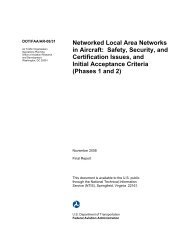Published Report (DOT/FAA/CT-94-36)
Published Report (DOT/FAA/CT-94-36)
Published Report (DOT/FAA/CT-94-36)
You also want an ePaper? Increase the reach of your titles
YUMPU automatically turns print PDFs into web optimized ePapers that Google loves.
P(A') = P(11)P(2')P(3') . . . P(10').<br />
The probability of an accident is then given by:<br />
P(A) = 1 - P(l')P(2')P(3') ... P(10').<br />
P(A) = 1 - (1 - P(1))(1 - P(2)) ... (1 - P(10)).<br />
= P(l) + P(2) + ... + P(10) + Q,<br />
where Q represents a sum of terms each involving products of<br />
probabilities, P(l) through P(10). Since each individual<br />
probability is very small, at most 4 x each term of Q must<br />
be of the order or less. Neglecting these terms, the<br />
probability of an accident, P(A), is given by:<br />
P(A) = P(l) + P(2) + ... + P(10).<br />
Although enormous amounts of time and money are spent on accident<br />
investigations, it is extremely difficult to pinpoint the exact<br />
cause of an accident. Therefore, it is extremely difficult in<br />
many cases to determine which of the ten causes referred to above<br />
should be assigned to a particular accident. Furthermore,<br />
because of the rarity of accidents due to each of the causes,<br />
much more data than that currently available would be necessary<br />
to estimate the risk of each of the ten causes. Therefore, it is<br />
apparent that estimates of the ten risks are, for practical<br />
purposes, impossible and that a different approach to the problem<br />
is necessary.<br />
This same problem is encountered in the design of an aircraft.<br />
According to FAR 25.1309, it was assumed arbitrarily that there<br />
are 100 potential failure conditions in an airplane which could<br />
contribute significantly to the cause of a serious accident.<br />
Since test data, historical data, or even theoretical estimates<br />
are unavailable for most of the causes, the allowable overall<br />
risk of a serious accident was apportioned equally among these<br />
conditions, resulting in an allowable risk for each of the<br />
failure conditions equal to 1/100 of the total risk.<br />
Since ten causes of a fatal accident during a parallel approach<br />
can be defined, it is reasonable to assign an equal probability<br />
to each of the causes. Since the overall probability of a fatal<br />
accident during a parallel approach is the sum of the<br />
probabilities of the component causes, each cause should be<br />
allocated 1/10 of the total probability. This leads to an<br />
allowable probability of 4 x lo-* or 1 fatal accident per 25<br />
million approaches. This approach should lead to a conservative<br />
risk allowance for collision since the risk of some of the ten<br />
causes may be so small as to be insignificant. This means that<br />
there are possibly fewer than ten significant causes so that the<br />
total risk could have been divided by a smaller number resulting<br />
in a larger allowable risk for collision.<br />
L-7

















